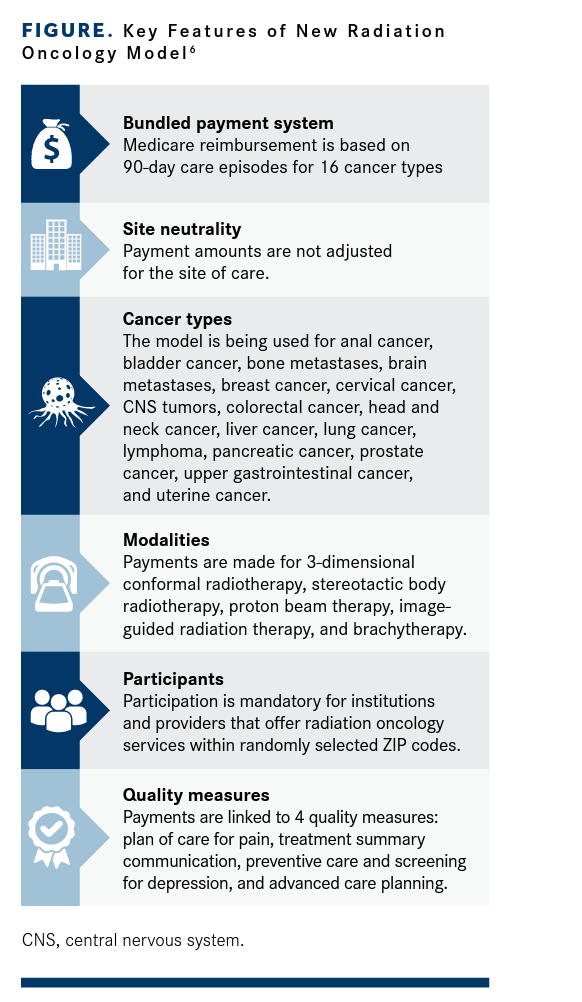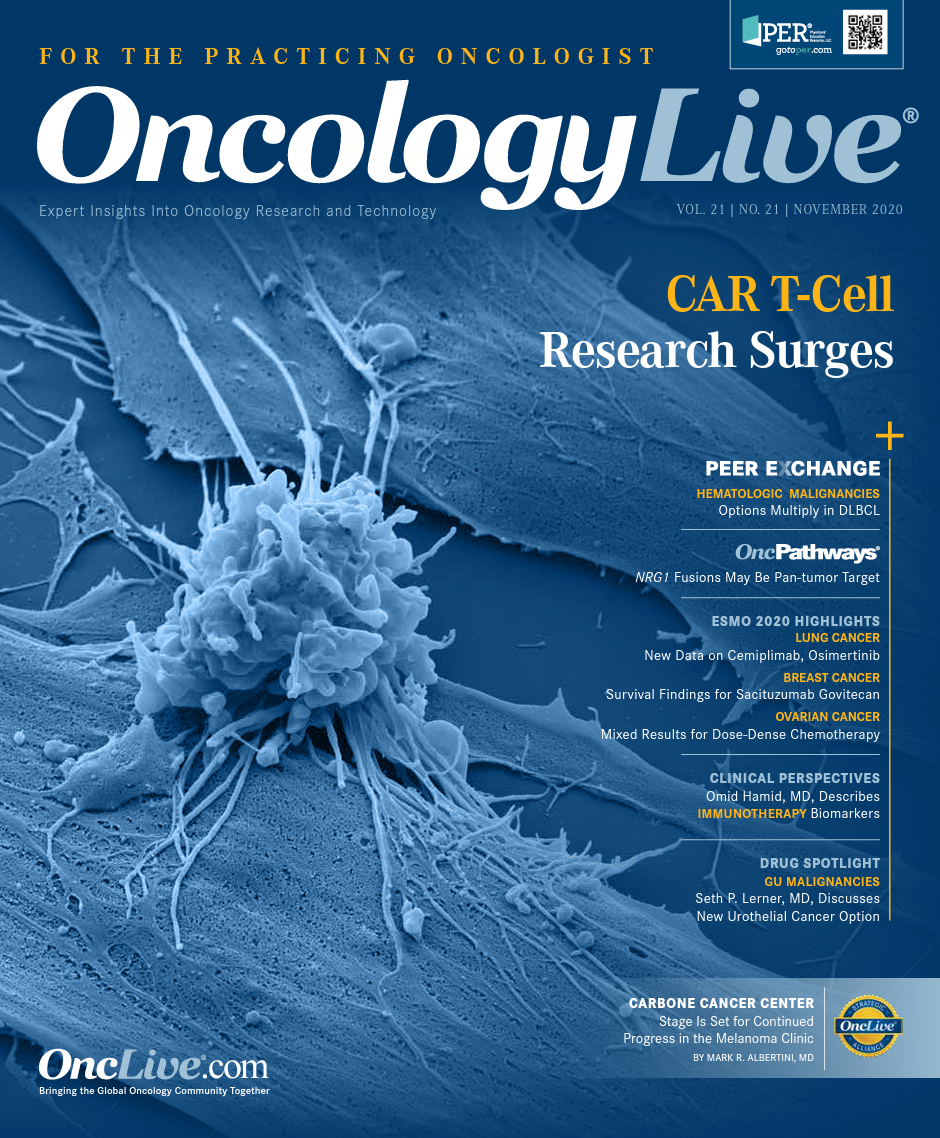Publication
Article
Oncology Live®
Radiation Oncology Leaders Bristle Over New Medicare Payment Model
Author(s):
Practices and cancer centers in randomly selected zip codes will be required to participate in the new radiation oncology Model, which is expected to cover approximately 30% of eligible Medicare fee-for-service care episodes.
David C. Beyer, MD

Starting in July 2021, the Centers for Medicare & Medicaid Services (CMS) will roll out a new model for reimbursing radiation oncologists for treating patients based on bundled payments rather than the current fee-for-service system, a change that is setting off alarm bells among providers. Practices and cancer centers in randomly selected zip codes will be required to participate in the new radiation oncology (RO) Model, which is expected to cover approximately 30% of eligible Medicare fee-for-service care episodes.1,2
Originally slated to begin January 1, 2021, the model was delayed based on feedback from stakeholders, CMS announced on October 21.
The model is structured as a way to test whether the bundled payment approach can reduce Medicare costs for radiation therapy (RT) while maintaining or improving quality of care for beneficiaries.2
The current fee-for-service reimbursement system is based on the number of treatments that patients receive and the care setting in which RT is offered, giving providers and suppliers an incentive to schedule therapy over more visits and favor one type of site over another, CMS said in announcing the RO Model.1 CMS estimates that the RO Model will save Medicare $230 million over 5 years.1
Radiation oncologists are bracing for a decrease in reimbursements.
“This is going to involve a significant cut in pay for me and my practice. I am confident it will be a very difficult program for me to participate in,” said David C. Beyer, MD, medical director of radiation oncology of Cancer Centers of Northern Arizona Healthcare in Sedona, said in an interview with OncologyLive®.
The implications for practices required to participate in the model are dire, particularly in light of the economic distress stemming from the coronavirus disease 2019 (COVID19) pandemic, said Dave Adler, vice president of advocacy at the American Society for Radiation Oncology (ASTRO). The pandemic has resulted in a 20% to 30% reduction in revenue for the average radiation oncology practice and has forced staff layoffs, according to ASTRO research.
“The RO Model ignores the ongoing pandemic and requires practices to make significant practice changes to comply with the January 1, 2021, implementation date,” Adler said in an email before CMS announced it was delaying implementation. “Financially, the RO Model will bring more pain to practices. According to the final rule, the RO Model will cut payments to group practices by 6% and hospital outpatient departments by 4.7%. Amazingly, these cuts are deeper than what CMS estimated in its proposed rule.”
The agency unveiled the new system on September 18, 2020, as part of a final rule on specialty care models, capping discussions about episode-based payment approaches that began in 2014.3 The model will be tested over a 5-year period.2
Although radiation oncologists had an opportunity to weigh in on proposed changes, the final rule fails to address many of the key concerns they raised, Theodore L. DeWeese, MD, chair of the ASTRO Board of Directors, said in a statement.4 DeWeese is also vice president for interdisciplinary patient care for Johns Hopkins Medicine, the Kimmel Professor of Radiation Oncology and Molecular Radiation Sciences, and director of the Department of Radiation Oncology and Molecular Radiation Sciences at the Johns Hopkins University School of Medicine in Baltimore, Maryland.
“The rule fails to accept the overwhelming majority of good faith recommendations provided by ASTRO, radiation oncology stakeholders, patients, and Congress,” Adler said. Constantine A. Mantz, MD, chief policy officer for 21st Century Oncology in Florida and vice-chair of ASTRO’s Health Policy Council, said ASTRO and other stakeholder groups in radiation oncology had devoted an unprecedented amount of time to engage with the Center for Medicare & Medicaid Innovation in a good faith effort to help develop a payment model that would realize savings and quality improvements while providing stable payments to sustain physician practices.
“The final rule does not meet the goals of reducing the administrative burden for the physician or providing stable reimbursement to support high-quality RT services across all practice settings and geographies,” Mantz said. “I hope that we will have an opportunity to redress the model’s most critical faults.”
FIGURE. Key Features of New Radiation Oncology Model6

Details of the New Model
Under the current fee-for-service structure, Medicare pays providers for each individual RT service they perform, and that payment can differ depending on where the patient received care, such as a hospital outpatient department, physician group practice, or freestanding radiation therapy center.
In 2017, the US Department of Health & Human Services identified 3 key reasons for changing the system: the lack of site neutrality for payments, incentives that encourage volume of services over the value of services, and coding and payment challenges.5
The RO Model provides bundled payments for a 90-day “episode” of care for 16 cancer types: anal cancer, bladder cancer, bone metastases, brain metastases, breast cancer, cervical cancer, central nervous system tumors, colorectal cancer, head and neck cancer, liver cancer, lung cancer, lymphoma, pancreatic cancer, prostate cancer, upper gastrointestinal cancer, and uterine cancer.2 Kidney care had been included in the proposed rule but was removed from the final rule.
The modalities covered by the bundled payments include external beam RT including 3-dimensional conformal RT, stereotactic radiosurgery, stereotactic body RT, proton beam therapy, image-guided RT, and brachytherapy.2 Intraoperative RT was not included in the final rule.
Participation in the program was randomized to represent 30% of all national episodes but this is roughly equivalent to 30% of eligible RT providers and suppliers, according to a spokesperson for CMS.
The proposal originally included 40% of radiation oncology episodes, Trevor J. Royce, MD, MPH, said in an interview. “It is still quite high and higher than some of the [other] alternative payment models that have come out,” he said.
The University of North Carolina (UNC) at Chapel Hill, where Royce is an assistant professor in the Department of Radiation Oncology, has been selected to participate in the program.
“We like to practice evidenced-based medicine, and the highest level of evidence comes from randomized controlled trials,” said Royce, who is immediate past vicechair of ASTRO’s Association of Residents in Radiation Oncology Executive Committee. “CMS needed enough participants to make sure this policy experiment was powered enough to see if there are savings being generated by the model.”
Adler said bundled payments could represent an opportunity to improve care and lower costs.
“Buried deep within the pile of the RO Model’s complex payment methodology, layers of mandated cuts, and burdensome requirements, there is a foundation for a sound episodic-payment model that incentivizes better care, instead of more care. Unfortunately, CMS has undermined the potential and promise of the model with unnecessary cuts and requirements that threaten its potential, along with the viability of required practices,” Adler said.
How Payments Are Structured
The reimbursement structure of the RO Model is complex, with much of the methodology driven by historical performance of the practice or institution. Adjustments are made for case mix, outside trends, and geographic location, as well as any withholding for performance on quality elements and incorrect payments.6
Episode payments are split into 2 components: a professional component (PC) payment, which is the payment to the physician, and the technical component (TC) payment, which is the payment for the equipment, supplies, personnel, and costs related to RT services.
CMS also applies a “discount” and withholds for errors, quality, and patient experience. The discount factor is the percentage that CMS reduces an episode payment. The discount factor for the provider is 3.75%, and the discount factor for the technical component is 4.75%. Practices can earn back some funds withheld for quality and patient experience based on clinical data and quality measure reporting.
CMS also applies a “discount” and withholds for errors, quality, and patient experience. The discount factor is the percentage that CMS reduces an episode payment. The discount factor for the provider is 3.75%, and the discount factor for the technical component is 4.75%. Practices can earn back some funds withheld for quality and patient experience based on clinical data and quality measure reporting.
CMS also applies a “discount” and withholds for errors, quality, and patient experience. The discount factor is the percentage that CMS reduces an episode payment. The discount factor for the provider is 3.75%, and the discount factor for the technical component is 4.75%. Practices can earn back some funds withheld for quality and patient experience based on clinical data and quality measure reporting.
“By issuing the same payment per cancer type, reimbursement is decoupled from the quantity and type of prescribed services. The physician, therefore, is incentivized to make the best clinical and cost-effective treatment decision for the patient. Ideally, the end result of such a model is a win-win-win scenario for patient, provider, and payer,” Mantz said. CMS will assess participants’ performance on measures of quality and patient experience and tie those assessments to payment. The rule requires participants to submit key clinical data that can be used for additional research, improvements to pricing, and the development of new quality measures specific to radiation oncology.
CMS will assess participants’ performance on measures of quality and patient experience and tie those assessments to payment. The rule requires participants to submit key clinical data that can be used for additional research, improvements to pricing, and the development of new quality measures specific to radiation oncology.
The RO Model qualifies as an Advanced Alternative Payment Model (APM) and a Merit-based Incentive Payment System (MIPS) APM under the Quality Payment Program. These are existing CMS programs that tie payments to quality and cost-efficient care. Practices that participate in the APM program must meet the RO Model requirements to receive incentive payments under the APM.
The RO Model assesses 4 quality measures: plan of care for pain, treatment summary communication, preventive care and screening for depression, and advanced care plan. Additionally, patients are to be given the Consumer Assessment of Healthcare Providers and Systems survey.
Impact on Radiation Oncologists
One of the biggest issues surrounding the RO Model is related to implementation. Participants will likely need a new technology infrastructure for coding and billing procedures, as well as a way to integrate that data into the electronic health record (EHR) to capture the required quality data.
CMS estimates that implementation costs related to the model would be less than $2000 in the first year and less than $1000 in subsequent years. But Mantz says this underestimates the needed modifications in billing and collections processes and likely EHR-related costs to comply with the model’s quality reporting requirements. “I would anticipate significant related costs for any size practice to adapt to these new requirements,” he said.
Beyer predicted this will likely cost his practice $10,000 to implement, in addition to his time.
“If MIPS was any indication, this will be 30 to 40 hours of my time where I am not seeing patients and I’m not reading articles to keep my skills up.”
Adler pointed out that payment rates won’t be available until December 2020, and then practices have to compare those rates with past payments to budget for 2021. “Some practices expect they will need to hire new staff to implement the complex new requirements, despite experiencing layoffs, hiring freezes, and financial strains due to COVID-19,” he said.
Another complicating factor, Royce said, involves large hospital networks that cover multiple zip codes or have clinics in different areas.
“It is still not entirely clear how that will play out if part of the health care system is included in the bundle and part of it is not,” he said. “UNC is one example of that.”
References
- CMS announces innovative payment model to improve care, lower costs for cancer patients. News release. Centers for Medicare & and Medicaid Services. September 18, 2020. Accessed October 9, 2020. https://go.cms.gov/2FfgKC2
- Radiation oncology model frequently asked questions (FAQs). Centers for Medicare & Medicaid Services. October 2, 2020. Accessed October 13, 2020. https://innovation.cms.gov/media/document/ro-model-faqs
- Radiation Oncology (RO) Model fact sheet. Centers for Medicare & Medicaid Services. September 18, 2020. Accessed October 9, 2020. https://go.cms.gov/3iRJ77i
- ASTRO responds to CMS Radiation Oncology Model: implementation delay and more reforms needed. News release. American Society for Radiation Oncology. September 18, 2020. Accessed October 9, 2020. https://bit.ly/2GFOxFe
- US Department of Health & Human Services. Report to Congress: episodic alternative payment model for radiation therapy services. November 2017. Accessed October 9, 2020. https://bit.ly/2SI4P2E
- Radiation oncology model. Centers for Medicare & Medicaid Services. Updated October 15, 2020. Accessed October 15, 2020. https://bit.ly/2GW1Zo0
























%20(2)%201-Recovered-Recovered-Recovered-Recovered-Recovered-Recovered-Recovered-Recovered-Recovered-Recovered-Recovered-Recovered-Recovered-Recovered-Recovered-Recovered-Recovered.jpg?fit=crop&auto=format)
%20(2)%201-Recovered-Recovered-Recovered-Recovered-Recovered-Recovered-Recovered-Recovered-Recovered-Recovered-Recovered-Recovered-Recovered-Recovered-Recovered-Recovered-Recovered.jpg?fit=crop&auto=format)
